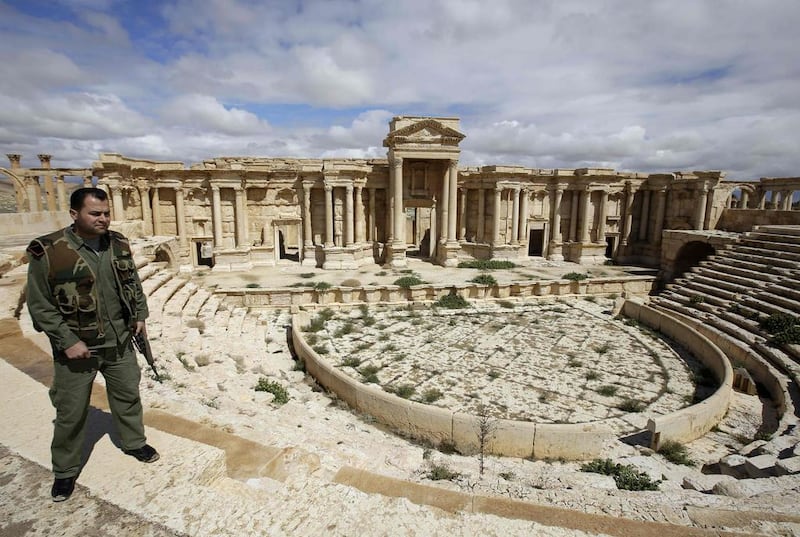GENEVA // Pro-government Syrian forces appeared poised to retake the famed ancient city of Palmyra from ISIL on Wednesday, as peace talks aimed at resolving the five-year conflict headed into their final stretch.
“The regime forces are now two kilometres away on the south side and five kilometres away on the west side,” said Rami Abdel Rahman, head of the Syrian Observatory for Human Rights.
ISIL seized the city in May, sending shock waves around the world as the group demolished some of the most treasured monuments of its Unesco-listed World Heritage Site.
Regime forces launched an offensive to retake the city at the start of the month backed by heavy Russian air strikes.
Moscow said last week that it was flying up to 25 sorties a day to help pro-government forces liberate what Russian president Vladimir Putin described as a “pearl of world civilisation”.
But ISIL has fiercely resisted the advance, killing at least 26 pro-government fighters on Monday alone, the Britain-based Observatory said.
Aamaq, an ISIL-linked news agency, claimed that 30 troops were killed in an attack by a suicide bomber.
ISIL also claims to have killed five Russian soldiers as well as Hizbollah fighters in the battle for Palmyra.
But there has been no confirmation from Moscow of the deaths of any soldiers or even of the presence of any military advisers on the ground.
The Kremlin has said that the offensive is being carried out by the Syrian army.
The recapture of Palmyra would be a strategic as well as symbolic prize for the regime.
Whoever controls the oasis city also controls the surrounding desert – an area of some 30,000 square kilometres extending to the Iraqi border.
That would cut ISIL’s area of control from some 40 per cent of Syrian territory to 30 per cent, according to the Observatory.
Meanwhile, negotiators in Geneva were making a fresh bid for a breakthrough ahead of a planned pause starting on Thursday.
There is some hope that high-level US-Russian meetings in Moscow this week could deliver the momentum needed to move on to a new round.
US Secretary of State John Kerry was on his way to the Russian capital on Wednesday and is scheduled to meet Mr Putin and foreign minister Sergei Lavrov on Thursday, with Syria a key issue on their agenda.
With the indirect negotiations in Geneva moving at a snail’s pace, all eyes are on the Moscow meetings since the US and Russia hold significant sway over the opposing sides in Syria’s brutal conflict.
“The diplomatic process in Geneva is interconnected with what is taking place in Moscow,” the High Negotiations Committee (HNC) said on Wednesday. The HNC represents Syria’s main opposition grouping.
It said it hoped that after the Kremlin talks “a clear message will be sent to [Syrian president] Bashar Al Assad: He cannot continue to paralyse the political transition that the Syrian people are demanding”.
“Syria’s future must be decided by the Syrian people, not by a single man,” said the council, whose leader, Riad Hijab, was set to hold a first official meeting with UN Syria envoy Staffan de Mistura on Wednesday.
Mr Al Assad’s fate has been a key obstacle in the latest talks, with the government stubbornly insisting that any discussion of him leaving is “excluded”. The opposition, meanwhile, says that any talk of allowing him to stay is “absolutely unacceptable”.
Despite this, Mr de Mistura voiced late on Tuesday “a strong expectation that the talks in Moscow will be productive”.
When the two powerful countries reach a “common understanding”, the process is helped “enormously”, the envoy said.
Washington and Moscow were instrumental in bringing about a partial, fragile truce declared on February 27, raising hopes for an end to the five-year Syrian conflict that has killed more than 270,000 people and forced millions to flee their homes.
The ceasefire does not include areas held by ISIL and Al-Qaeda linked Jabhat Al Nusra, which allowed the regime to launch the offensive to retake Palmyra.
Meanwhile, Moscow, which made a surprise announcement last week that it was withdrawing most of its troops from Syria, has since continued support for the government’s bid to liberate the city.
* Agence France-Presse





